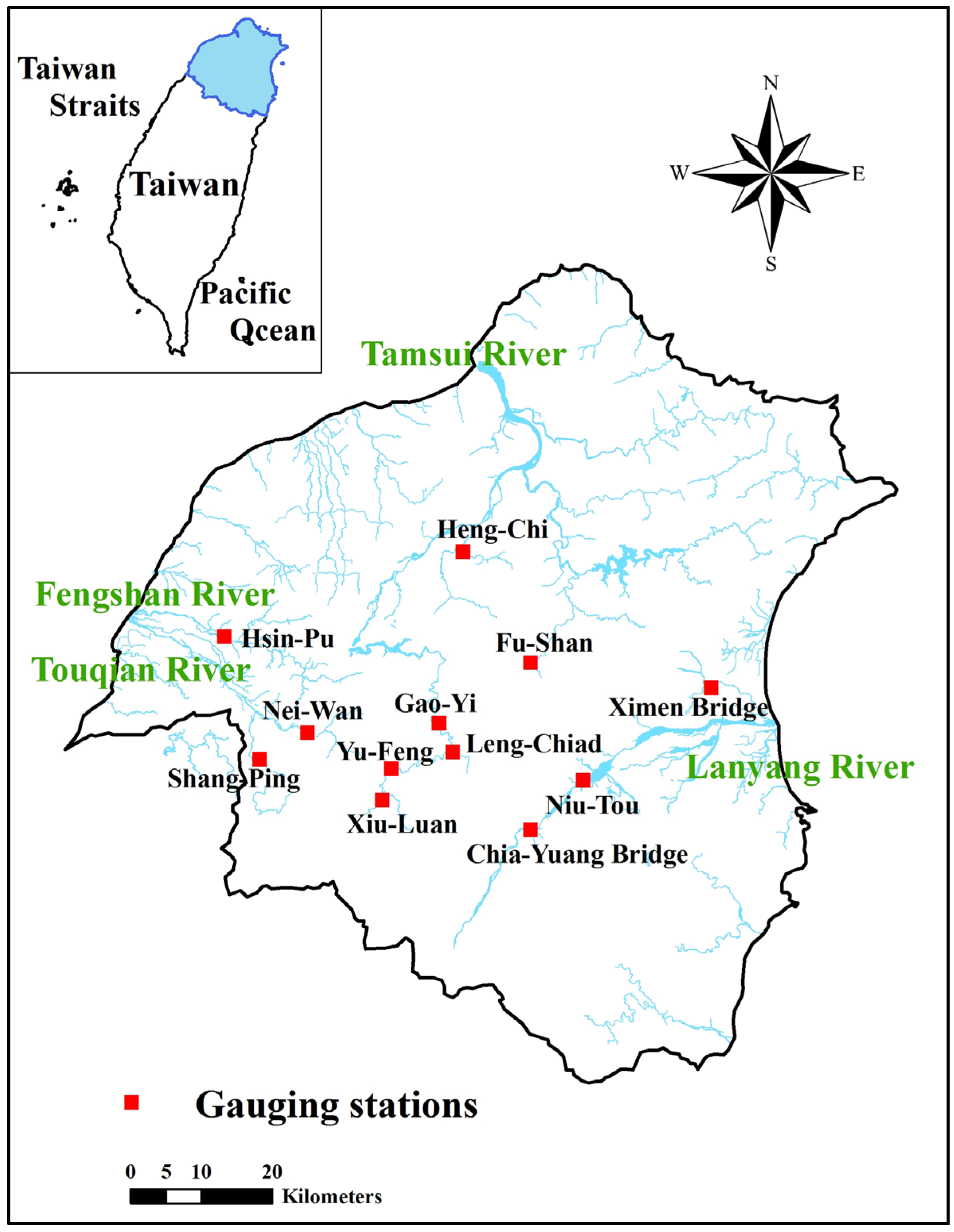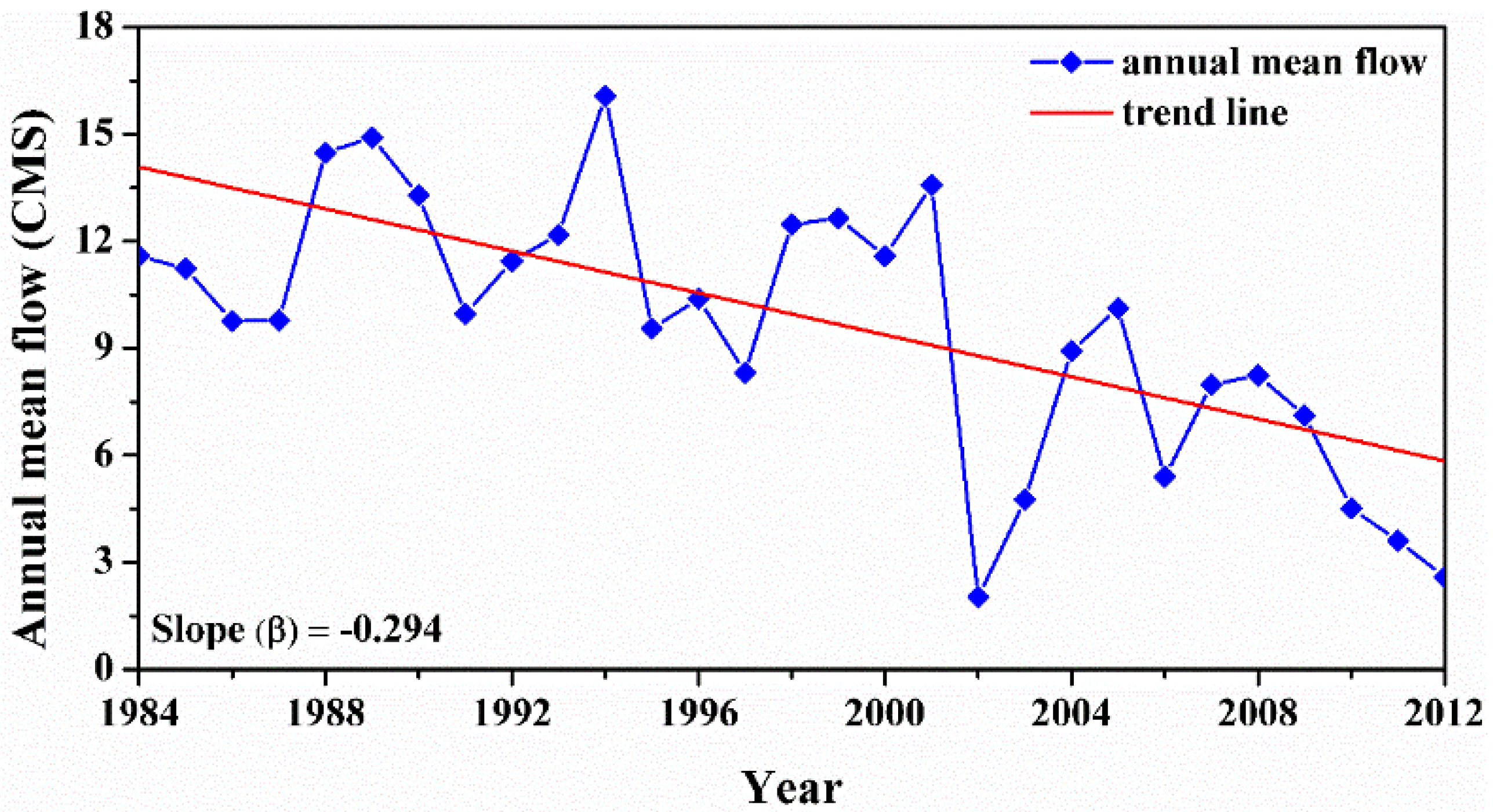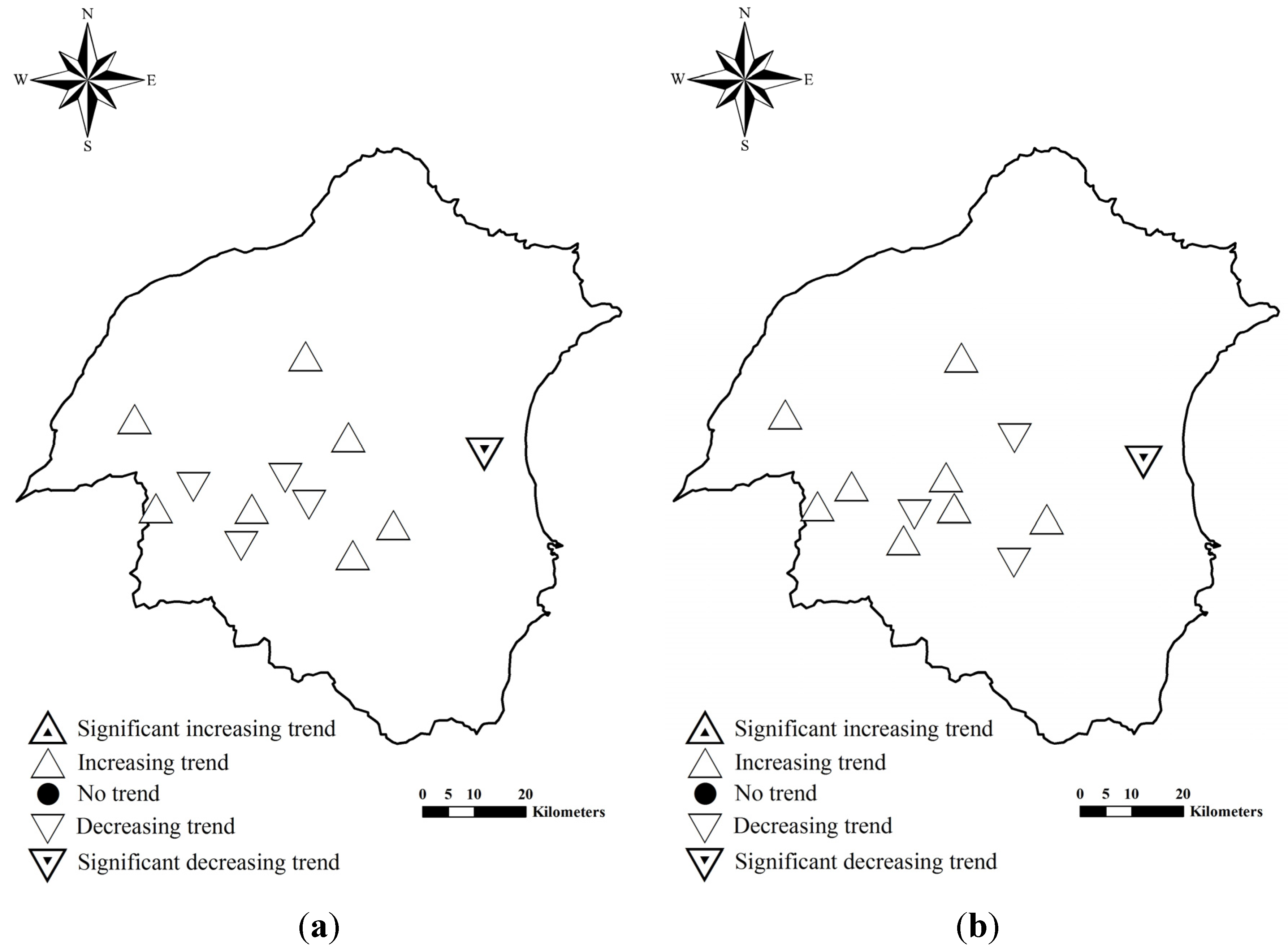1. Introduction
Due to global warming, the global climate has experienced drastic changes such as the rise in global temperature, the increase in melting ice in the Alps and the North and South Poles, and uneven rainfall distribution [
1]. These changes have had a significant impact on hydrological factors, such as streamflows, base flows, and groundwater levels. Investigations on hydrological factor trends have thus become increasingly crucial [
2,
3,
4]. Located at the boundary between the Philippine Sea Plate and the Eurasian Plate, Taiwan features violent plate activity and a rapid rise in terrain altitude. For example, the Western regions contain plains that average 100 m in elevation while the Central and Eastern mountain range have mountains that average 3000 m in elevation. Because of the rapid rise in terrain altitude, streams in Taiwan are short and turbulent. Streamflow is an important factor in studies of water resource management, floods, and droughts. In addition, dramatic climate change has created extreme rainfall distributions, making the study of streamflow trends and variability even more crucial.
The Mann-Kendall test has been widely used in streamflow trend analysis. Concerning research on mainland-based climate zones, Lins and Slack [
5] analyzed data from 395 U.S. gauging stations in climate-sensitive regions using the Mann-Kendall test, with results showing general upward streamflow trends; only a few Northwestern and Southeastern regions exhibited downward streamflow trends. The results showed that the climate in the U.S. is humid but has not reached extreme humidity. Zhang
et al. [
6] investigated 30–50 years of streamflow data collected from 11 Canadian gauging stations, with results showing that during this period, the average monthly streamflow frequently decreased, and the average annual streamflow decreased for southern cities. Kahya and Kalayci [
7] analyzed the monthly streamflow data for 26 Turkish basins over the past 31 years, with results showing downward streamflow trends, which could be attributed to a drop in rainfall and a rise in temperature. Chen
et al. [
8] selected the Kaidu River basin, located in the Northwestern Arid Region of China, as the study area and conducted an analysis using annual streamflow data from 1960 to 2009. They then conducted trend and change point analyses using the Mann-Kendall test and the Mann-Kendall-Sneyers test, respectively. The results of their analyses revealed that the Kaidu River basin showed a significant annual streamflow increase and that the change point occurred in 1993. They subsequently divided the time periods into 1960–1993 and 1994–2009, where the former was defined as a “natural period” and the latter as a “human-induced period.”
Regarding research conducted on island-based climate zones, Dixon
et al. [
9] analyzed the seasonal and annual data collected from 56 West England gauging stations. The data time period spanned 40 years (from 1962 to 2001). The study results showed significant upward streamflow trends for both high and low flows, whereas the average streamflow remained relatively stable. Dixon
et al. [
9] subsequently divided the streams into East and West, where the Western mountainous region showed significant upward streamflow trends, particularly in high flow during the fall and winter. Baggaley
et al. [
10] investigated the 1929–2004 streamflow records of the Dee River in Northeast Scotland and found that when investigating the streamflow and rainfall spatio-temporal correlation changes, one must also consider factors that contribute to snowfall changes in the alpine catchment area. This is because snowfall is highly correlated to downward rainfall trends. Their study also found that to highlight the peak streamflow in a correlation system, the use of hours as the unit of measurement is superior to the use of days. Hannaford
et al. [
11] analyzed the 1969–2008 data of 89 U.K. catchment areas, with the study results showing that seasonal data analyses are prone to the influence of irregular runoff increases, high flow in the winter and fall, and low flow in the spring. Observations made of the lowlands in Southeast England revealed the presence of spatial heterogeneity in trends. Therefore, when increasing the scale of the basin in a study area, one must carefully consider the issue of spatial heterogeneity. Bassiouni and Oki [
12] analyzed the 1913–2008 streamflow data for Hawaii using the Mann-Kendall test, with results showing that both the high and maximum flow trends exhibited significant decreases.
The Mann-Kendall test is primarily used to determine whether a series of numbers demonstrate a significant trend. However, it cannot be used to calculate the extent of the upward or downward trend. Therefore, a trend slope calculation method is normally used in conjunction with the Mann-Kendall test. The Theil-Sen estimator is a commonly used trend slope calculation method, particularly in a hydrological factor trend analysis. In such an analysis, it is used together with other trend analysis methods to perform quantitative analyses on trend significance [
11,
12,
13,
14,
15]. Thus, in this study, the Theil-Sen estimator is used to calculate the trend slopes to obtain the extent of trend changes.
When performing long-term trend analyses on hydrological factors, the trends obtained signify the overall characteristics of the hydrological factors. However, world climate change has created dissimilar hydrology trends at different time periods. The intersection where two dissimilar trends meet is called a change point. To determine whether change points exist in the long-term data in this study, the Mann-Whitney-Pettit test and the cumulative deviation test, two tests commonly used in hydrology analyses, are used [
14,
16,
17,
18].
As mentioned, the Mann-Kendall trend test is widely used in the spatio-temporal analyses of streamflow sequences for various climate regions. Thus, streamflow trends were analyzed in this study. As a densely populated area, the northern regions of Taiwan have a high demand for water. However, climate change over recent years has created climate anomalies, resulting in severe water shortages during the originally rainy winter and spring seasons [
19]. To reduce the impact of climate change on water use in the northern regions of Taiwan, the hydrology information of the regions must be fully understood and effectively managed. To explore the streamflow changes in the northern regions of Taiwan, the long-term streamflow data of 12 gauging stations in the regions are selected. The average annual streamflow, average monthly streamflow, and high and low flows are analyzed using the Mann-Kendall test, and significant trends and distribution changes are discussed. The trend slope is calculated using the Theil-Sen estimator, which produces the amount of change in trends. Finally, the change points in the long-term streamflow data are identified using the Mann-Whitney-Pettit test and the cumulative deviation test, and the changes in streamflow before and after the change points are explored. These research methods are used to determine long-term streamflow trend changes in the northern regions of Taiwan and the trend change spatial variability.
3. Study Area
In this study, the northern water resource regions listed by the Water Resources Agency of the Ministry of Economic Affairs were selected as the study area. These regions include the following administrative areas: Yilan County, Keelung City, New Taipei City, Taipei City, Taoyuan County, and Hsinchu County. The regions contain five terrain types, namely, plains, hills, highlands, basins, and mountains. Regions featuring plains primarily comprise the Taoyuan Alluvial Fan, the Hsinchu Plains, and the Eastern Yilan Delta; regions containing hills consist of the Keelung Hills and the Zhudong Hills; regions with highlands include the Linkou Plateau; regions with basins include the Taipei Basin; and regions featuring mountains primarily comprise the northernmost Tatun Mountains and the Central Backbone Range. These regions embody a variety of terrain characteristics; terrains ranging from those less than 100 m in elevation (plains), to less than 500 m in elevation (hills), and to more than 1000 m in elevation (mountains).
Rainfall in the northern regions of Taiwan during the summer and winter seasons primarily comes from typhoons and northeast monsoons, respectively. The Northern Taiwan regions receive rainfall all year long. For example, the Yilan region can have up to 350 days of rainfall. The average annual rainfall in the northern regions of Taiwan is 2937 mm, which is higher than that in Central, Southern, and Eastern Taiwan.
The main rivers in the Northern Taiwan regions are the Tamsui River, the Lanyang River, the Fengshan River, and the Touqian River, which have drainage basin areas of 2726, 978, 250.1, and 565.9 km
2, respectively. The historical overall average annual streamflow is approximately 15.1 × 10
9 m
3, which is lower than those of the central, southern, and eastern regions. Historical data show a significant difference in the Northern Taiwan region streamflow between the dry and wet seasons, where the overall streamflows are approximately 5.62 × 10
9 and 9.48 × 10
9 m
3 during the dry (November to April) and wet (May to October) seasons, respectively [
19].
In this study, the long-term streamflow data for the Northern Taiwan regions collected by the Water Resources Agency of the Ministry of Economic Affairs are used for analysis. Data from 12 gauging stations in the Northern Taiwan regions not affected by artificial water conservancy facilities are selected. The geographical locations of the gauging stations are shown in
Figure 1.
Figure 1.
Locations of study area and streamflow stations.
Figure 1.
Locations of study area and streamflow stations.













